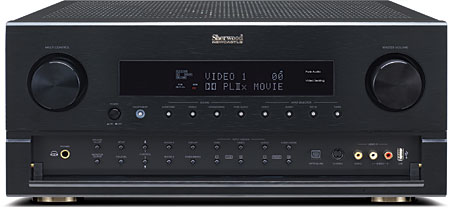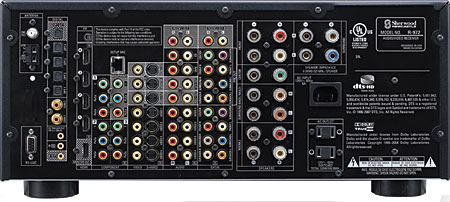| Columns Retired Columns & Blogs |
Music in the Round #42
An audio/video receiver in Stereophile? Heresy!
Well, my following report on the Sherwood Newcastle R-972 A/V receiver with Trinnov Audio Optimizer ain't the first time, but I recall the outrage of subscribers when, in December 2000, Larry Greenhill reviewed the Denon AVR-4800 and editor John Atkinson put it on the magazine's cover. Since then, however, Stereophile has reviewed everything from iPods to PC soundcards to minisystems, and while AVRs are unlikely to become a common subject of reviews, in some situations there are good reasons to consider using one. I did that in the January 2006 issue with the Denon AVR-4806, when I wanted to get a handle on Audyssey's then-new MultEQxt Room Equalization system.

For the same reason, I want to look now at the first consumer implementation of the Trinnov Optimizer MC system, the professional version of which is a $13,000 software/hardware package that lets mastering engineers equalize, mix, and structure the soundstage in three dimensions. In cost and complexity, it's not something for even the above-average home system, although a detailed review by David Rich, written for consumers, was published in The $ensible Sound in 2007. The user interface demands advanced knowledge of sound and acoustics and of the scientific terminology for both—and, of course, along with the power to shape acoustics and rearrange the soundstage comes the ability to really screw it up. Any consumer version of such a system should retain the ability to measure the room acoustics and speaker setup, correct the in-room frequency response, and compensate for suboptimal speaker and listener positions in all three planes. (That last feature is unique to the Trinnov Optimizer.) Moreover, such a system should not confuse the user, or make it too easy to make the sound worse.
However advanced and useful the features of its included Trinnov Optimizer may be, the Sherwood Newcastle R-972 ($1799.95) must first be a solidly performing product with the full range of expected options, along with good DACs and analog outputs—and, since this is an AVR, good power amps. Out of the box, the R-972 is a typical black block whose front panel sports two large knobs flanking an illuminated display panel. Below this is a row of pushbuttons and, below that, behind a trap door at the bottom, additional controls and inputs. On the rear panel is the usual bewildering array of inputs and outputs demanded both for cutting-edge connectivity (including HDMI, RJ45, and USB), as well as for back-compatibility with analog audio and video devices. Suffice it to say that the R-972 is replete; I'll let Sherwood fill in the minutiae here.

I used the R-972 primarily as a preamplifier-processor, with its line-level outputs connected to my Bryston 9B-STT five-channel power amplifier, but a one-day session with the Sherwood's own 130W amps revealed they were of high enough quality and power for a high-end AVR, if a little lacking in sheer grunt at the bottom end compared to the Bryston. Either way, the R-972's sound quality was much better than I'd expected, with excellent balance and integration within and between channels. With analog or digital sources, it was clearly a step up from the Integra DTC-9.8, which it displaced. Given the small differences to be expected in decoding and DSP processing (room equalization aside, for the moment), I suspect that the Sherwood's advantage is in its analog input stage and its output stage, as the latter is common to all signal paths. Indeed, used without Trinnov processing and connected to a front trio of either PSB Image T6 or Paradigm Studio 60/v3 speakers (with a pair of Studio 20s for surrounds and a Sub 15 subwoofer), the system sounded excellent, lacking only the increments of transparency, transient response, and low-end detail that characterize far more expensive processors, such as the Arcam AV888 and the Classé CT-SSP. Well done, Sherwood.
On the other hand, the R-972 suffers from some niggling operational foibles to which I found myself unable to adapt. First, except for two little windows that will go unused in a single-zone system, the remote control is not backlit, and its small labels are difficult to read in anything less than bright lighting.
Second, there's no way to set a default audio mode for each input format. Since I prefer to listen to almost all sources in their native formats, I choose Stereo for two-channel sources, but want appropriate decoding for all the rest. If you listen in stereo and change channels, the Sherwood will, by default, downmix Dolby Digital to two-channel. Even worse, switch from a nicely decoded Dolby Digital source to a stereo source and the R-972 will reprocess it into a surround mode, with unpredictable results. Pushing a button or two on the remote will cure this, but did you know that, in Stadium mode, a news anchor sounds like the Voice of God? Scary.
- Log in or register to post comments




































